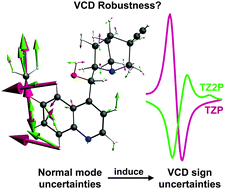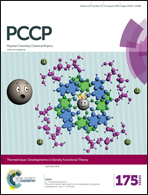Revisiting an old concept: the coupled oscillator model for VCD. Part 2: implications of the generalised coupled oscillator mechanism for the VCD robustness concept†
Abstract
Using two illustrative examples it is shown that the generalised coupled oscillator (GCO) mechanism implies that the stability of the VCD sign computed for a given normal mode is not reflected by the magnitude of the ratio ζ between the rotational strength and dipole strength of the respective mode, i.e., the VCD robustness criterium proposed by Góbi and Magyarfalvi. The performed VCD GCO analysis brings further insight into the GCO mechanism and also into the VCD robustness concept. First, it shows that the GCO mechanism can be interpreted as a VCD resonance enhancement mechanism, i.e. very large VCD signals can be observed when the interacting molecular fragments are in favourable orientation. Second, it shows that the uncertainties observed in the computed VCD signs are associated to uncertainties in the relative orientation of the coupled oscillator fragments and/or to uncertainties in the predicted nuclear displacement vectors, i.e. not uncertainties in the computed magnetic dipole transition moments as was originally assumed. Since it is able to identify such situations easily, the VCD GCO analysis can be used as a VCD robustness analysis.

- This article is part of the themed collection: Developments in Density Functional Theory

 Please wait while we load your content...
Please wait while we load your content...